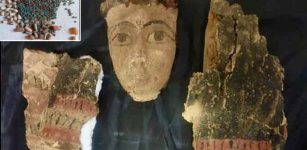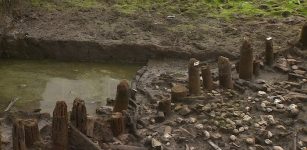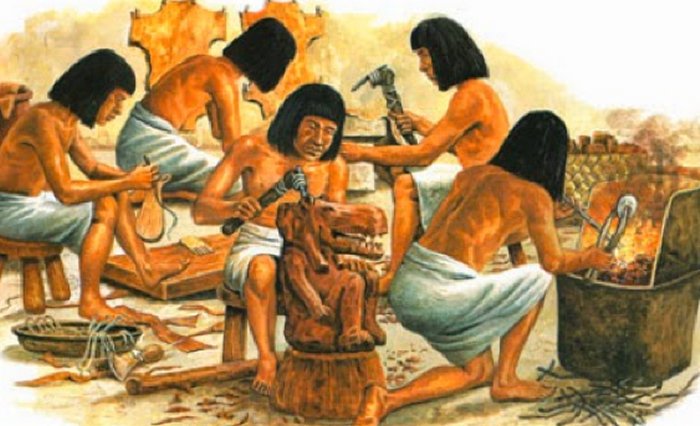What Ancient Civilization Discovered Metallurgy?
AncientPages.com - The science behind metallurgy goes far back in time, but it's uncertain when and where humans invented metal smelting.
Researchers now think they have found the answer to this long-debated question in the history of technology. Apparently, metallurgy does not have a single origin, but probably arose at various locations at about the same time.
The experts reached this conclusion after re-examining the 8,500-year-old copper slag and analyzing the chemical composition of other copper artifacts from the Stone Age settlement of Çatalhöyük in the Near East.
Scientists have debated for a long time who discovered metallurgy.
There is evidence copper metal was already being processed at the beginning of the Neolithic Age approximately 10,000 years ago in the Fertile Crescent from the Levant through East Anatolia to the Zagros Mountains in Iran.
"But because this is all pure, native copper, we can't really call it true metallurgy," explains Prof. Dr Ernst Pernicka, Scientific Director of Heidelberg University's Curt Engelhorn Centre for Archaeometry, which is located in Mannheim.
Copper is found in nature as metal, and according to the researchers, was probably considered a special type of stone. But because the production of metal from ore ushers in a new era in human history, it is important to know when and where it first developed and whether metal smelting really originated in a single location.
See also:
Aluminum Was Used At Least 7,000 Years Ago – Long Before The Metal’s Official Invention In 1825
Telangana And Great Ancient Iron Masterwork Of Skilled Blacksmiths Of India
It was long believed that a small amount of copper slag from the Neolithic site at Çatalhöyük was thought to be the earliest evidence for pyrometallurgical extraction of copper from ore.
This settlement existed from approximately 7,100 to 6,000 BC and is considered to be the most significant site in the Near East that affords any insight into the development of human habitats. The copper slag was located in layers that dated back to 6,500 years before Christ and was therefore 1,500 years older than the world's earliest evidence of copper smelting.
Copper bead from Çatalhöyük. It consists of very pure copper in metal form, as found in nature. Image credit: Picture: M. Radivojevic, CC BY-NC-SA 3.0
"The find seemed to point to the birthplace of metallurgy, with the technology slowly spreading from there in all directions," states Prof. Pernicka, who also heads the Archaeometry and Archaeometallurgy Research Group at the Institute of Earth Sciences at Heidelberg University.
However new studies, including those at the Curt Engelhorn Centre for Archaeometry, have demonstrated that the slag was an unintentional by-product of a domestic fire. The extreme heat of the fire slagged the green copper ores, which were used as pigment. The slag differs in chemical composition from another artefact from the Stone Age settlement, a bead of folded sheets made of pure copper.
This threw new light on the scientific significance of the copper slag of Çatalhöyük, now putting the earliest known examples of copper extraction from ore around 5,000 BC in Southeast Europe and Iran.
The current findings indicate that this revolutionary development in humankind probably came about at roughly the same time but in multiple locations. "We thereby solved a controversial problem in the history of technology," underscores Professor Pernicka.
AncientPages.com
Expand for referencesMore From Ancient Pages
-
 Earliest Document Written 2,100 Years Ago May Rewrite History Of The Basque Language
Archaeology | Nov 17, 2022
Earliest Document Written 2,100 Years Ago May Rewrite History Of The Basque Language
Archaeology | Nov 17, 2022 -
 Monstrous Nomoli Figures Left By Unknown Culture That Vanished Long Ago
Artifacts | Mar 13, 2023
Monstrous Nomoli Figures Left By Unknown Culture That Vanished Long Ago
Artifacts | Mar 13, 2023 -
 Maximilien de Robespierre: A True Revolutionary Man Or A Madman?
Featured Stories | Dec 22, 2015
Maximilien de Robespierre: A True Revolutionary Man Or A Madman?
Featured Stories | Dec 22, 2015 -
 Long-Lost Ancient Burial Mounds Of The Havana Hopewell Culture Re-Discovered In Iowa
Archaeology | Apr 6, 2021
Long-Lost Ancient Burial Mounds Of The Havana Hopewell Culture Re-Discovered In Iowa
Archaeology | Apr 6, 2021 -
 Rainbow Was A Powerful Symbol In People’s Ancient Beliefs
Ancient Symbols | Jul 26, 2018
Rainbow Was A Powerful Symbol In People’s Ancient Beliefs
Ancient Symbols | Jul 26, 2018 -
 On This Day In History: Du Fu – ‘The Sage of Poetry’ Was Born – On Feb 12, 712
News | Feb 12, 2017
On This Day In History: Du Fu – ‘The Sage of Poetry’ Was Born – On Feb 12, 712
News | Feb 12, 2017 -
 Vikings Had Dark Humor And Joked Even During Deadly Battles
Vikings | Aug 20, 2024
Vikings Had Dark Humor And Joked Even During Deadly Battles
Vikings | Aug 20, 2024 -
 Viking Women Were More Prominent Than Previously Thought – Archaeological Discoveries Reveal
Archaeology | Sep 6, 2019
Viking Women Were More Prominent Than Previously Thought – Archaeological Discoveries Reveal
Archaeology | Sep 6, 2019 -
 Mystery Of Ancient Sarcophagi In Egypt
Ancient Mysteries | Aug 26, 2015
Mystery Of Ancient Sarcophagi In Egypt
Ancient Mysteries | Aug 26, 2015 -
 Relics Dated To Byzantine And Late Period Unearthed In Meir Necropolis In Assiut, Upper Egypt
Archaeology | May 15, 2023
Relics Dated To Byzantine And Late Period Unearthed In Meir Necropolis In Assiut, Upper Egypt
Archaeology | May 15, 2023 -
 Can You Solve The Mystery Of The Nessglyph? Archaeologists Ask
Archaeology | Jan 31, 2023
Can You Solve The Mystery Of The Nessglyph? Archaeologists Ask
Archaeology | Jan 31, 2023 -
 Tumlehed Rock Art And Seafaring In Stone Age’s Sweden
Archaeology | Nov 11, 2019
Tumlehed Rock Art And Seafaring In Stone Age’s Sweden
Archaeology | Nov 11, 2019 -
 Archaeologists unearthed artifacts in a 3,700 year-old mine factory
Artifacts | Aug 22, 2015
Archaeologists unearthed artifacts in a 3,700 year-old mine factory
Artifacts | Aug 22, 2015 -
 Egyptian King Seti I Documented His 3300-Year-Old Accomplishment On Triumphal Stele
Archaeology | Feb 27, 2023
Egyptian King Seti I Documented His 3300-Year-Old Accomplishment On Triumphal Stele
Archaeology | Feb 27, 2023 -
 The Pompeii Of The Fens: Ancient Village In Cambridgeshire Burned Down 3,000 Years Ago For Unknown Reasons
Archaeology | Jul 14, 2016
The Pompeii Of The Fens: Ancient Village In Cambridgeshire Burned Down 3,000 Years Ago For Unknown Reasons
Archaeology | Jul 14, 2016 -
 On This Day In History: Dante Alighieri Famous For His ‘Divine Comedy’ Born – On May 9, 1265
News | May 9, 2016
On This Day In History: Dante Alighieri Famous For His ‘Divine Comedy’ Born – On May 9, 1265
News | May 9, 2016 -
 Unravelling The Mystery Of Apollonius Of Tyana – Was He A Superhuman?
Ancient Mysteries | Sep 17, 2015
Unravelling The Mystery Of Apollonius Of Tyana – Was He A Superhuman?
Ancient Mysteries | Sep 17, 2015 -
 100,000-Year-Old Case Of Deafness Discovered In Fossilized Skull Of Hunter-Gatherer
Archaeology | Jul 21, 2022
100,000-Year-Old Case Of Deafness Discovered In Fossilized Skull Of Hunter-Gatherer
Archaeology | Jul 21, 2022 -
 New Inscriptions, Gold And Paint Showed Thanks To Restoration In Temple Of Edfu
Archaeology | Sep 20, 2024
New Inscriptions, Gold And Paint Showed Thanks To Restoration In Temple Of Edfu
Archaeology | Sep 20, 2024 -
 Tomb Of Pharaoh Ramesses II Treasurer Ptah-M-Wia Discovered In Saqqara
Archaeology | Nov 4, 2021
Tomb Of Pharaoh Ramesses II Treasurer Ptah-M-Wia Discovered In Saqqara
Archaeology | Nov 4, 2021


